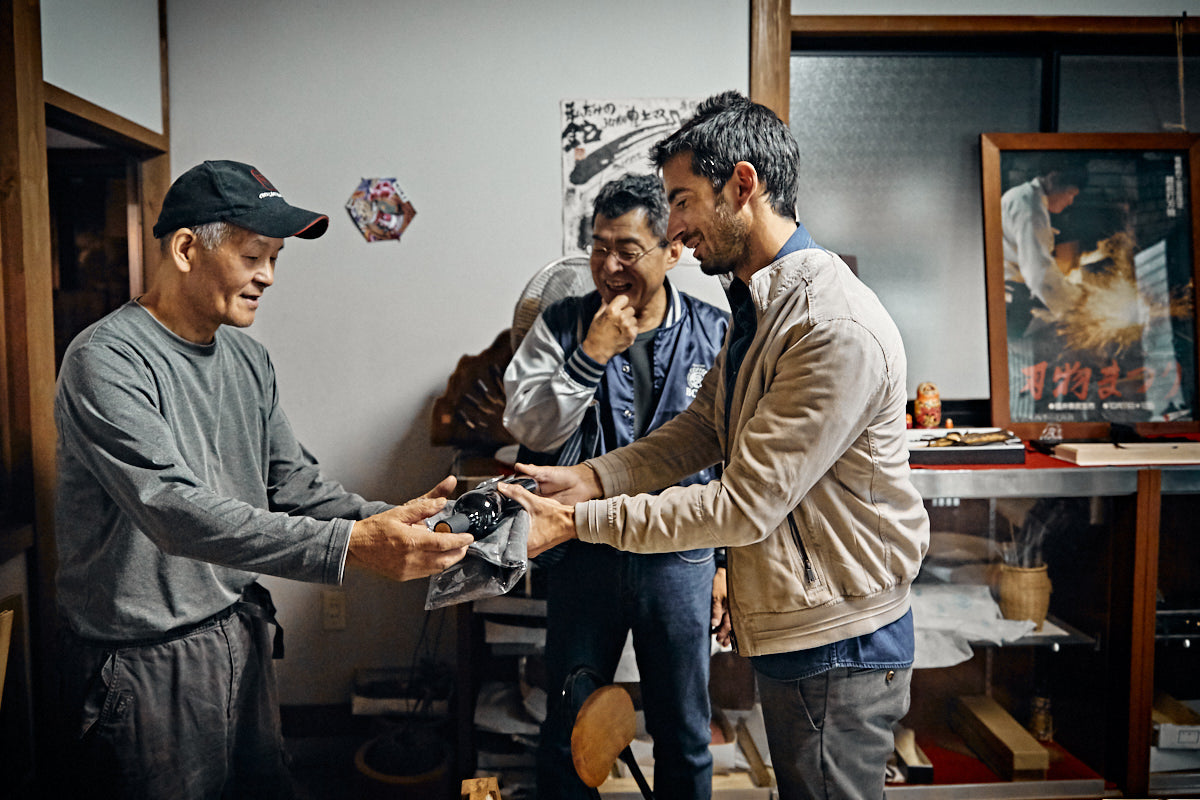Takeshi Saji grew up in a family of blacksmiths and spent his days at the workshop, observing how his father, like the father before him, by employing great skill and working hard transformed a piece of steel into a stunning handicraft – a knife. In the evenings, he attended the blacksmith training school (along with blacksmiths-to-be Kato-san, Kitaoka-san and others) where he acquired theoretical knowledge about forging and metallurgy. Since childhood, he therefore knew that, someday, he’d also become a blacksmith. Even today, in his eighties, he never looks back.
Takeshi Saji (1948) is one of the most distinguished blacksmith masters in Japan. In 1992, he was officially certified as a “Traditional Master Craftsman”, a prestigious title awarded only to the best craftsmen in Japan. He’s the third-generation blacksmith and his workshop is located at the Takefu Knife Village in Echizen, where he forges knives together with his two apprentices. During the period of a decrease in demand for hand-crafted, forged products, Saji found a niche in producing top-of-the-line hunting knives, which were sold in Japan and abroad. To add his special touch, in addition to hand-picked wood, he also used animal horns for making handles and, over time, became a leading expert on Western type handles in the region. Yu Kurosaki and other masters from the Takefu cooperative also honed their skills under his guidance.
Later, artisanal kitchen knives regained popularity. Always ready to adapt and change, Saji-san again focused on making kitchen knives in 2007. His first pieces bear traces of robustness, a remnant of his vast experience in making outdoor knives, while today his knives are one of the most sought after in the world, mainly among collectors and real connoisseurs who admire his eye for fine finish and thirst for innovation. He has made great strides in forging kitchen knife blades and, considering the numerous times he appears in specialized magazines and the increase in demand for his knives, it doesn’t look like he’ll be out of work any time soon.
The buyers of his knives find him intriguing, mostly due to his unbounded enthusiasm to experiment with new shapes and materials and to develop original techniques. He’s not afraid to take on a challenge and prefers to use steels that are demanding to work with, such as VG-10, R2, Shirogami and Aogami Super. His Rainbow Damascus knives are greatly coveted and they entail a special type of lamination first developed by master Saji himself – the blade is made from several layers of stainless steel which alternate with additional layers of bronze, copper and brass. With its unique suminagashi pattern and breathtaking beauty, it stands out among other Damascus blades.






 The photos above were taken during our visit to the smithy at the Takefu Knife Village in Echizen, Japan. Photographer: Mitja Kobal. 👆
The photos above were taken during our visit to the smithy at the Takefu Knife Village in Echizen, Japan. Photographer: Mitja Kobal. 👆Glossary:
Suminagashi: floating ink is a term that denotes marbling and it first appeared in Japan in 12th century.
Takefu Knife Village: a cooperative jointly owned by small blacksmiths in the town of Echizen in Japan from where many master blacksmiths hail from.
